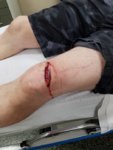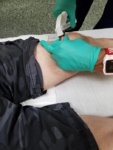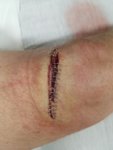First time ever cutting up dozens of critters, I cut my left index finger on a solo backpack trip in designated wilderness this year. I should say that my brother had just left for home hours before, so I was solo at the time of the incident. Bled like a stuck pig and was ticked off at myself for the mistake and the time it took to properly deal with it as I was back in some seriously rugged country and a ton of work to do to get back to camp. Bit of a mini epic night...
Direct pressue is the key. Direct pressure until it stops bleeding--can take some time. Don't keep pulling the bandage off too look. That can stop the clotting process and start the bleeding all over again. A gusher can really take a long time to clot up. If bandage soaks through just add another on top. When it's controlled, wrap it with whatever tape you have to keep the bandage in place. I've always got some Gorilla duct tape wrapped around the shaft of my trekking poles--good stuff. That's what I used at that point.
I don't carry a suture kit on hunting trips, but do have one for wilderness open ocean sea kayaking trips because help can be so far and long away and expensive. One of my paddling partners is a doc, though, so it makes that more practical. I'd do it on someone else or myself if needed. Not really a choice at that point. But, generally, you still need to get the bleeding under controlled before you suture, generally. If needed, the wound should be closed with sutures or 'liquid stitches' within 6-8 hours. The liquid stitches work well too...had a cheek split to the bone under my eye put together with that. Split it on the job and our department doc used the liquid stitches back at the station--all free, no paperwork and one less trip to the ER--nice!
Back to the wound, Don't take the bandage off for quite a while and unless somewhere you have have ability and supplies necessary and preferably someone else to help deal with it--this is when you might consider doing a little cleaning and using some antibacterial treatment like neosporin, etc.. Initially, the priority is getting the bleeding stopped. The more bleeding, the higher the priority this is. If there is actually spurting blood, you may have gone deep enough to hit an artery and priority one becomes even more important and can take longer. I've used Celox powder a couple of times on folks with arterial bleeds squirting--just pour it in the wound and bandage. Stuff works. Had a guy once though, that was on blood thinners and he fell striking his head on the corner of a chest of drawers and had a squirter coming out of his temple area. Any of u guys ever dehorned cattle? It was a little bit like that--place was a mess. Nothing but hold direct pressure all the way to the ER--nowhere to put any Celox.
Heard a story of a guy that was drunk (ETOH reduces ability of blood to clot and 'thins' blood), cut himself in the thumb, went home to sleep and died in his drunken sleep from an uncontrolled cut on his thumb. Just to say circumstances can come together and make a 'small' issue life threatenting. Same issue if someone is already on anti-coagulants/blood thinners.
There's probably others on here with a better understanding and experience than I and I'm not saying the above is at all complete. I'm not an ER doc....



